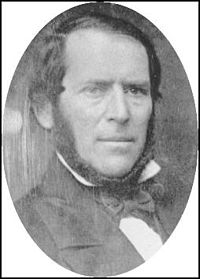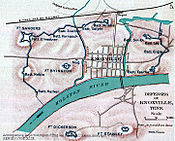- Danville Leadbetter
-
Danville Leadbetter 
Danville LeadbetterBorn August 26, 1811
Leeds, MaineDied September 26, 1866 (aged 55)
Clifton, CanadaBuried at Magnolia Cemetery in Mobile, Alabama Allegiance United States of America
Confederate States of AmericaService/branch Confederate States Army Years of service 1836–57 (USA)
1861–65 (CSA)Rank Captain (USA)
Brigadier General (CSA)Battles/wars American Civil War Danville Leadbetter (August 26, 1811 – September 26, 1866) was a career U.S. Army officer and later he served as a Confederate general during the American Civil War.
A trained engineer, Leadbetter supervised the construction of forts before and during the war, and is noted for his controversial involvement in the November 1863 Battle of Fort Sanders in eastern Tenneesee. Afterward the conflict he left the United States and lived out the remainder of his life on foreign soil.
Contents
Early life and career
Danville Leadbetter was born in Leeds, Maine. He attended the United States Military Academy in West Point in July 1832, and graduated four years later, standing third out of 49 cadets. He was commissioned a second lieutenant in the 1st U.S. Artillery on July 1, 1836. Leadbetter transferred to the Army Engineers on November 1, but as a brevet second lieutenant to rank from July 1. He then returned to the 1st Artillery on December 31, and went back and forth between the two regiments and ranks throughout 1837. Leadbetter was promoted to first lieutenant on July 7, 1838, and was promoted to captain on October 16, 1852.[1]
Leadbetter spent 1853–57 at Mobile, Alabama, working on the construction and/or repair of the city's harbor forts.[2] He resigned from the U.S. Army on the last day of 1857 and settled in Alabama. There he later became the state's chief engineer.[1]
Civil War service
Choosing to follow his adopted home state and the Confederate cause, entered service in the Confederate States Army on March 16, 1861, as a major in the army's regular engineers. He was sent to Mobile, Alabama, to oversee the defenses under construction. By August 3 he was the acting chief of the Confederacy's Engineer Bureau, a post he would hold until November 11.[3] Two days later Leadbetter returned to Mobile and continued his work there.[4] He was promoted to the rank of lieutenant colonel that October.[1]
Leadbetter was promoted to brigadier general on February 27, 1862, and began his Western Theater service. In May he was given command of the 1st Brigade in the District of East Tennessee (Department Number Two), and held this position until July 3.[1] He next served as the Engineer of various Confederate districts and armies, and was assigned Chief Engineer of the Department then Army of Tennessee in the fall of 1863.[5]
Knoxville
As the Chief Engineer of the Army of Tennessee, Leadbetter was responsible for the layout of the Confederate defensive lines prior the siege and Battle of Chattanooga.[2] During Lt. Gen. James Longstreet's Knoxville Campaign that winter against Union-held Knoxville, Tennessee, Leadbetter was sent by army commander Gen. Braxton Bragg to aid the Confederate planning against the Federal positions. Leadbetter arrived on November 25 and consulted with Longstreet, using his prior knowledge of the fortifications in Knoxville he had designed the year before.[6]
For two days Longstreet, his subordinates, and Leadbetter reconnoitered the Union lines around Knoxville. After a second look at Fort Sanders, the dominating feature of the Federal defenses, Leadbetter recommended to hit them there.[7] The result of this counsel led to the selection of the attack route and the ultimately unsuccessful Battle of Fort Sanders on November 29.[6]
Leadbetter's last Confederate command was the District of the Gulf (Department of Alabama, Mississippi, & East Louisiana) from November 22 to December 12, 1864. There is no record of him receiving a parole from the U.S. Government when the Civil War ended.[1]
Postbellum
After the war Leadbetter fled to Mexico (as did many other ex-Confederate officers) and then went to Canada, where he died in Clifton in 1866. His body was returned to Alabama and buried in Magnolia Cemetery within the city of Mobile, Alabama.[1]
Assessment
Exactly how much and the quality of Leadbetter's service to the Confederate Army is debatable.[8] Military historian Ezra J. Warner states he was usually highly thought of by several of his superiors;[9] however Edward Porter Alexander, whom Leadbetter served with during the Knoxville operations, was critical in post-war writings of his involvement and influence in the campaign.[10]
Alexander believed that in the selection of the artillery site to attack Fort Sanders, "Leadbetter evidently had no appreciation of the ground" he himself had earlier assessed as unpracticable and very exposed.[10] Alexander believed Longstreet knew better, "but was misled in some way I have never [been] able to understand"[10] and that accepting Leadbetter's recommendations "robbed him of most of his few remaining chances of victory."[8]
Engineer assignments and dates
Leadbetter was the lead engineer of the following Confederate units, followed by his starting date:
- Chattanooga, Tennessee, from July 10, 1862
- District of the Gulf,[11] from October 19, 1862
- Department of Tennessee, from July 25, 1863
- Army of Tennessee, from October 23, 1863
- District of the Gulf,[12] from April 30, 1864[1]
See also
Notes
- ^ a b c d e f g Eicher, p. 342.
- ^ a b Warner, p. 176.
- ^ Eicher, p. 72; Weinert, p. 99. Eicher states he possibly assumed this position on August 22, 1861, while Weinert gives the earlier date of August 3.
- ^ Weinert, p. 99.
- ^ Wert, p. 348.
- ^ a b Wert, pp.349-53.
- ^ Mendoza, pp. 129-31.
- ^ a b Warner, p. 177.
- ^ Warner, p. 177. "...apparently highly esteemed by such officers as General Bragg, Beauregard, Maury, and Joseph E. Johnston...
- ^ a b c Wert, p349.
- ^ part of Confederate Dept. No. Two.
- ^ part of Confederate Dept. of Ala., Miss. & E. La.
References
- Eicher, John H., and Eicher, David J., Civil War High Commands, Stanford University Press, 2001, ISBN 0-8047-3641-3.
- Mendoza, Alexander, Confederate Struggle For Command: General James Longstreet and the First Corps in the West, Texas A&M University Press, 2008. ISBN 1-60344-052-6.
- Warner, Ezra J., Generals in Gray: The Lives of the Confederate Commanders, Louisiana State University Press, 1989, ISBN 0-8071-3150-4.
- Wert, Jeffery D., General James Longstreet: The Confederacy's Most Controversial Soldier: A Biography, Simon & Schuster, 1993,
ISBN 0-671-70921-6. - Weinert, Richard P., Jr., The Confederate Regular Army, White Mane Publishing, 1991, ISBN 0-942597-27-3.
Further reading
- Wilson, John Alfred, Adventures of Alf. Wilson: A Thrilling Episode of the Dark Days of the Rebellion, National Tribune, 1897.
External links
- google.com link to book Adventures of Alf. Wilson: A Thrilling Episode of the Dark Days of the Rebellion.
Categories:- 1811 births
- 1866 deaths
- People from Androscoggin County, Maine
- People of Maine in the American Civil War
- Confederate States Army generals
- United States Military Academy alumni
- United States Army officers
Wikimedia Foundation. 2010.

